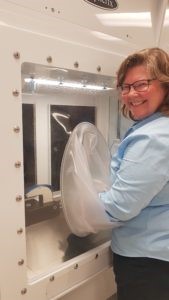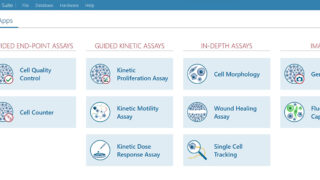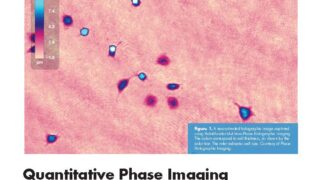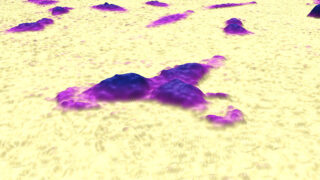Growing & Analyzing Cells at their Best

Environment Control & Cell-friendly Monitoring is the Key
BioSpherix and Phase Holographic Imaging (PHI) have teamed up to support researchers in their ambition to grow and analyze cells in a cell-friendly environment, without cell disturbing factors like labels, stains and temperature fluctuations.
PHI has developed HoloMonitor M4, a live-cell imaging technology which allows label-free and non-invasive cell analysis. BioSpherix has developed Xvivo system® which ensures a controlled, isolated and contaminant-free environment for cell culture. With the cell’s wellbeing at the top of the mind, the cooperation has created a cell-friendly environment where cells can be analyzed, monitored and filmed under optimal conditions.
The first collaborative results were already presented with posters at the Annual Meeting for the Society of Toxicity in Baltimore and at the Annual meeting for American Association of Cancer Research earlier this year. We showed that controlled temperature conditions during cell plating reduce the troubling edge effect in 96-well plates. Overcoming this problem will have enormous impact on time and resources for cell-based toxicity assay setups.
We are excited about collaborating with PHI. The combination of our Cytocentric technology with PHI’s HoloMonitor technology provides the ability to monitor cells label-free in full-time physiologically relevant oxygen conditions. This opens the way to more physiologically relevant results for biomedical sciences
Dr Alicia Henn
BioSpherix
“I went to Parish in July 2018 to visit Dr Alicia Henn, CSO at Biospherix, and her team”, says Kersti Alm, Head of Biology at PHI. “We put HoloMonitor into an Xvivo system isolator. Then we all excitedly waited to see how HoloMonitor affected the controlled environment of the Xvivo. HoloMonitor didn’t have any adverse effects on either particles, temperature or anything. That’s really amazing”.

Kersti Alm
BioSpherix® has worked with many cell researchers and scientists to uncover the benefits of culturing and processing cells in a physiologic environment. The need led to the creation of the Xvivo System® platform, allowing entire protocols to be run sterile, controlled, and optimized with the cell’s need in focus. The Xvivo System® is the first Cytocentric® isolator. The modular design can handle any cell production process – small or large, simple or complex, manual or automated.
PHI can provide researchers with a cell friendly as well as fast and easy-to-use live-cell imaging tool. The HoloMonitor enables label-free and kinetic live-cell studies during optimal physiological conditions – by being placed right inside your incubator. The cooperation with BioSpherix contributes towards a more relevant environment for cell research with the well-being of the cells in focus.
By using the Xvivo System to completely control cell conditions and HoloMonitor to visualize and quantify the effects on cells, we see this collaboration as the perfect combination of technologies to answer many long-standing questions in cell biology.
Dr Alicia Henn
BioSpherix
In the Xvivo systems, levels of oxygen and CO2 as well as humidity and temperature, can be regulated and monitored in detail. As the systems are isolated towards the external environment, they allow for a fully controlled environment during cell handling and incubation. Importantly, HoloMonitor did not affect the regulated conditions while being placed inside of the system. Even very close monitoring could not reveal any adverse effects on the environment in the Xvivo.
The first study completed through this cooperation concerned the known edge effect problems when seeding micro plates. It is a classical problem caused by the liquid dynamics when liquids of different temperatures are mixed together. It causes cells to settle at the edges of the wells rather than being homogenously distributed. The poster1 showed both with images and quantitative data from HoloMonitor that different temperature combinations caused different degrees of edge effect. Most importantly, using the temperature-controlled environment of the Xvivo system®, edge effect was minimized. The cells settled randomly and well distributed over the well which is a relevant factor for setting up cell-based toxicity assays.
Using a cell-friendly and regulated cell environment is key for successful experiments. Excluding the edge wells from an assay setup and filling them with buffer to tackle the edge effect problem, is not only causing a great loss in usable assay space, but also wasting materials and money. Instead, focus on what matters: your cells.

Dr Alicia Henn, working with HoloMonitor placed in an Xvivo System isolator.
Posters
- Controlled Conditions Reduce Critical Edge Effect in 96-Well Plates, A. M. Frank, S. Henn, A. Henn, K. Alm, S. Darou, and R. Yerden, SOT - Society of Toxicology (2019)
- Eliminating Edge Effect in 96-well Plates by Controlling Thermal Conditions during Cell Plating, Shannon Darou , Alicia D. Henn , Allayna M. Frank, Kersti Alm , Randy Yerden, AACR - American Association for Cancer research annual meeting (2019)


